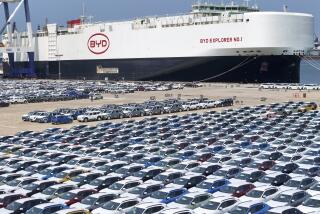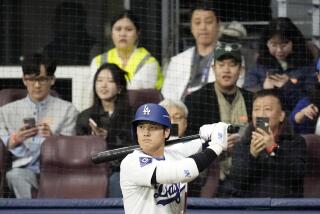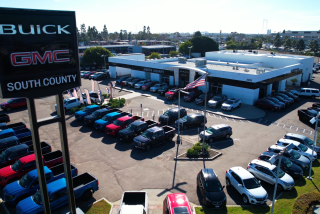Hyundai’s Drive to Improve Its Line Paying Off
Once-lowly Hyundai Motor Co., the auto maker that gave South Korean cars a black eye in the U.S. a decade ago, has quietly surged past a sliding Mazda Motor Corp. to become the No. 5-selling Asian brand in the country.
It is a symbolic victory, as Hyundai so far specializes in subcompact and compact cars that don’t compete with much that the Japanese offer. But in a market in which appearance counts, outselling a well-known brand such as Mazda is an important symbol nonetheless.
Retail sales tallies for the first four months of the year show that Hyundai, with no trucks or sport-utility vehicles in its lineup, has sold 76,446 cars to capture a 1.4% share of the U.S. market.
Mazda, once thought to have a firm grip on fourth place in the sales race among Asian car makers, has dropped to sixth with 74,659 sales and a 1.3% market share.
A resurgent Mitsubishi Motors Corp. of Japan, pumped up with a stable of redesigned models, glowing press reviews and a consistent marketing message, booted Mazda out of fourth place last year and continues to hold that slot this year with 94,853 sales and a 1.6% market share through April.
This year’s story, though, is Hyundai, a seeming comeback kid leading a surge of South Korean car sales. Combined, Korean auto makers Hyundai, its Kia Motors Corp. subsidiary and Daewoo Motor Co. had a 2.5% share of the U.S. passenger-vehicle market at the end of April, up from 1.5% for the same period in 1999.
And though the South Koreans still trail the pack in the widely watched J.D. Power & Associates initial-quality study--Kia finished dead last in 37th place this year; Daewoo was 36th, Hyundai, 34th--they can still boast honestly of building better cars, analysts say.
The reason? Where quality studies once measured the distance between winners and losers in the hundreds of defects, many of them serious engine and transmission problems, the gap today is much narrower and the kinds of problems reported far less serious.
In the economy end of the market, quality is no longer an issue, said Thad Malesh, director of North American market forecasting at J.D. Power & Associates in Agoura Hills.
Consumers are comfortable that it is there and are more concerned with features and cost, the so-called price-value relationship.
“And all of the Koreans are marketing cars with great price-to-value,” Malesh said.
Encinitas, Calif., roofing contractor Jim Brown swears he had never heard of Hyundai cars until a friend bought one eight months ago. Now, basing his decisions partly on Hyundai’s strong sales showing, he owns a pair: compact Accent economy models he bought for his college sophomore son and high school senior daughter.
The cars each have logged several thousand miles without problems, Brown said, noting: “They don’t even rattle, and I can’t say that about the new Ford F-150 pickup I bought for work, and it cost three times as much.”
Hyundai, in particular, has learned to build competitive cars, said Dan Gorrell, vice president of Strategic Vision.
The San Diego market research firm publishes an annual new-car buyer survey that this year ranked Hyundai’s Sonata sedan fifth among 16 cars in the compact segment and its Elantra sedan in seventh among 20 competitors in the small-car segment.
“We’ve been hoping to sneak up on everyone quietly,” said Finbarr O’Neill, president and chief executive of Fountain Valley-based Hyundai Motor America Inc.
“We’re not targeting Mazda, or anyone else. Our biggest challenge has been our image, and that’s what we are concentrating on.”
The rest, he said with a satisfied smile, has just followed.
For their part, Mazda executives say they are not in a race with Hyundai, have seen their own sales rise 2.7% this year, and expect momentum to pick up this summer with the re-pricing of the Miata roadster, the accolades being racked up by the Protege compact sedan and the addition to its lineup of the new Tribute, Mazda’s first SUV in six years.
Hyundai’s nascent turnaround is all about the importance of quality in a market that sometimes seems obsessed with price and content.
The company, which scored strong sales but ultimately burned thousands of U.S. customers in the late ‘80s with the low-priced but cheaply built Excel economy car, has steadily improved quality and reliability this decade.
But it wasn’t until last year--when Hyundai executives in the U.S. persuaded corporate policy makers in Seoul that they needed to show American consumers they meant what they were saying--that things took off.
That’s when Hyundai Motor America launched what it calls the country’s best warranty: full powertrain coverage for 10 years or 100,000 miles on top of a bumper-to-bumper warranty and free roadside assistance for five years or 60,000 miles.
“They have clearly found a message to use to distinguish themselves,” said Herbert Tay, Western region leader for A.T. Kearney Inc.’s Global Automotive Practice.
Hyundai’s sales philosophy was “us or the bus” before 1990, he said, referring to the positioning of its new cars as an alternative to used cars or public transportation.
“But when they came in with their 10-year [warranty] proposition, it attracted a new mix of customers,” Tay said. Where Hyundai dealers used to sell 70% of their cars to the so-called sub-prime market of buyers with credit problems or marginal employment, today they sell about the same percentage to prime credit customers.
(BEGIN TEXT OF INFOBOX / INFOGRAPHIC)
Making Their Marques
South Korean auto makers are winning over once-wary American buyers with improved quality, generous warranties and cars that generally offer more standard features for the money. Overall sales have grown 74% in a year.






